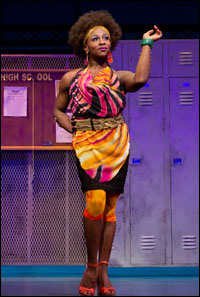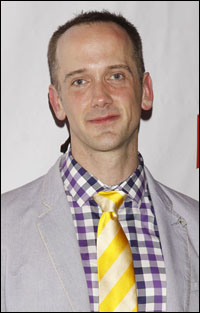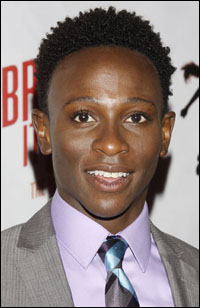
Over the past 40 years New York theatre audiences have encountered the Cagelles of La Cage aux Folles and the girls of Priscilla, as well as transgendered rocker Hedwig and the biographical account of Charlotte von Mahlsdorf in I Am My Own Wife.
While some of these works have been bolder than others in terms of theatrical activism, each of the productions singles out gender-experimenting within their narratives, asking audiences point blank to address intolerance, or their own feelings on seeing life from a different angle, as Jerry Herman once put it. But Bring It On, which centers around a high school cheerleading cat fight royale, shuffles the transgender card into its deck of characters without forcing its hand.
"In creating a universe of characters, I always try to find as many differing perspectives as possible, because that's where comedy comes from most often," says Bring It On book writer Jeff Whitty, who earned a Tony Award for Avenue Q. The stage production is based on the film franchise of the same title, but utilizes a cast of new characters and a fresh plot for the stage incarnation, which launched a U.S. tour in Los Angeles last fall prior to its Broadway arrival.
Among the spunky, new high school characters is La Cienega, one of three black girls in a hip-hop dance crew at Jackson High, the urban school where Bring It On's blonde, apple-cheeked protagonist Campbell is transferred. Early in the musical's first act, Whitty introduces audiences to La Cienega, portrayed by actor Gregory Haney, without any fanfare. She strides onto stage with her crew as one of the girls. Although Haney's muscles may raise an eyebrow or two, no mention is made in the dialogue that she is transgender.
Whitty says he didn't want La Cienega's inclusion to become too saccharine in an "after-school special way," where the character is forced to explain herself, delivering a heavy-handed lesson. "In that case they become the other, they become a separate person, which allows an audience to put them in a box and keep them in a box," he says. "When I thought that I wanted to have a transgender high school student, my next thought was, I just never want to really bring it up and never discuss it in the script. Then the audience can't see La Cienega as the other; they have to become her friend. That, more than anything, is how progress is made," he notes.
| |
 |
|
| Haney in Bring It On: The Musical. | ||
| photo by Joan Marcus |
For Haney, who appeared on Broadway in Memphis, Tarzan and Wicked, La Cienega's carte blanche acceptance is timely. "With everything that's going on in the country with teen suicides and beatings, there's a strong message in the show that isn't bashed into the audience's head," he says. "There's something peaceful about acceptance and letting people be what they want to be and that it's okay. At the end of the day it really doesn't affect you, because you are still going to live your life the way you want to live your life."
"There are big misperceptions about transgender people," Haney adds. "I'm trying to really give it the respect that it deserves. It's a hard thing to get up every day and be true to yourself and then have backlash from people who don't want you to be who you are supposed to be."
La Cienega was one of the final roles to be cast. Whitty says he wasn't sure if an actor actually existed who could inhabit the role honestly and also harness the "fierceness" required by the girls at Jackson High. The creative team auditioned transgender performers for the role, but Whitty points out that the pool of represented talent in the trans community is currently very small. Drag performers were also brought in, but "there was a lot of sort of commenting on femininity," he recalls.
Luckily, Haney was a few blocks away preparing to come in for final callbacks. Dressed in an Afro wig, a headband, lip gloss and four-inch heels, Haney says he knew that if he could walk "the gauntlet" from a friend's apartment to the audition room, he could get a taste of the courage it took to be La Cienega.
| |
 |
|
| Jeff Whitty | ||
| Photo by Joseph Marzullo/WENN |
This isn't to say Bring It On doesn't address La Cienega's identity and that audiences aren't caught off guard. Haney doesn't overtly manipulate his voice on stage, and La Cienega gives another character a quick reality check on what it means to be an outsider. To that extent, audiences, many of which include families with 'tween girls dressed in cheerleading attire, are embracing the character and how she is represented.
"The timing of when Gregory fully speaks took some calibration," Whitty laughs. "I love it when the audience is floored! I love when the audience freaks out. They realize that the character is transgender or that there is gender-mixing going on. I love that initial shock, because it is matched at the end by the ovation that Gregory gets. It shows that they've come full circle. So, I never freak out when there's that initial 'OH!' response."
"It's progressive. There are people coming to the show who aren't exposed to city life, who might never see a transgendered person like we do here in New York, or even the gay and lesbian population," Haney says. "I'm really proud. Bring It On is really about acceptance in general. It might say to kids, 'You don't know, this might be the coolest person you're ever going to meet.'"
Haney has had the chance to meet some of those cool people. "There was this woman patiently waiting outside the stage door in L.A. She was transgender and she came up to me and said, 'I just wanted to say, thank you.' I said, 'No, thank you,'" Haney recalls. "It really warms my heart to know that I am representing a community that has very few positive representations or even influences in the limelight. So to actually be part of it – to maybe change people's minds or perceptions – that might last a lifetime. It really does affect me in a greater way than I ever thought could possibly happen."
| |
 |
|
| Haney on opening night | ||
| photo by Joseph Marzullo/WENN |
The acceptance is being proven nightly, in what Whitty calls a "deafening air-raid siren" of whoops and cheers when La Cienega gets kissed during the finale. The moment had been somewhat obscured on the tour, but the creative team chose to have a full-on kiss become part of the Bring It On finale when the musical arrived in New York.
"It's a nice cherry on top, because everyone is pulling for the underdog, and I love that La Cienega gets her moment at the end," says Haney. Whitty adds, "The most important thing is that there are variations on gender and there is real humanity in that. I think that is the key for the audience to understand."
For Whitty, Haney and the rest of the Bring It On team, the goal, to borrow a lyric from the musical, is to show that "It Ain't No Thing" to be who you are.
As La Cienega sings:
Love who you are
And the world will adore you –
And the couple that don't
At least they can't ignore you!
Now all the boys want to buy me bling –
It ain't no thing.









